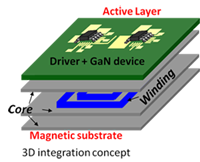LIBRARY
Power Supplies on Chip

(Advanced Research Projects Agency - Energy, Agile Delivery of Electrical Power Technology)
Performance Period: September 1, 2010 - August 31, 2012
Partner Organizations: International Rectifier, University of Delaware
ARPA-E Program Director: David Danielson | CPES-Virginia Tech Project Contact: Fred C. Lee
Critical Need:
Today every processor is powered with one of this multi-phase voltage regulator (VR). Due to relatively low switching frequency, 300-600 KHz, the passive components such as inductors and capacitors are bulky. They occupy a considerable foot-print (about 30%) on the motherboard. To save the motherboard real estate for other critical functions, two things have to happen simultaneously. One is a significantly increase in switching frequency of VRs to reduce the size and weight of inductors and capacitors. The second is to integrate passive components with active components. Today, this concept has been demonstrated at a level less than 5A . It is far from meeting the needs for such applications as notebook, desk-top and server applications where tens and hundreds of amperes are needed.
Project Innovation Advantage:
Recently, CPES has successfully demonstrated the 3D integration of PSOC that used ferrite-based LTCC magnetics as substrate upon which power devices and drivers were mounted. With this design, the power density reaches as high as 700W/in3, a factor of 7 improvements over the current VR. The concept of integration above will be further refined by using the new generations of GaN devices with the chip scale integration to achieve even higher operation frequency (5-10MHz) and higher power density (1000W/in3). A new high frequency Fe-based nanocomposite magnetic material will be developed and used as the substrate.
Impact:
If successful, CPES's high-current high-density integrated POL will free up 90% of the motherboard space currently occupied by VRs for other critical functions. it will enable the U.S. power management IC industry to maintain their technology leadership.
- SECURITY: It will enable U.S. corporations to continue to lead the world in the development of more advanced computer, telecommunication and all forms of mobile equipment and ready-made power management solutions.
- ECONOMY: The motherboard footprint and price will both be reduced, which will stimulate the further growth of IT industries.
- JOBS: It will enable U.S. power management IC industry to regain their market share as major suppliers for the total POL converter system solution as they once had a decade ago. As a result, many related jobs will be created.
View: ARPA-E PSOC Overview






















































































